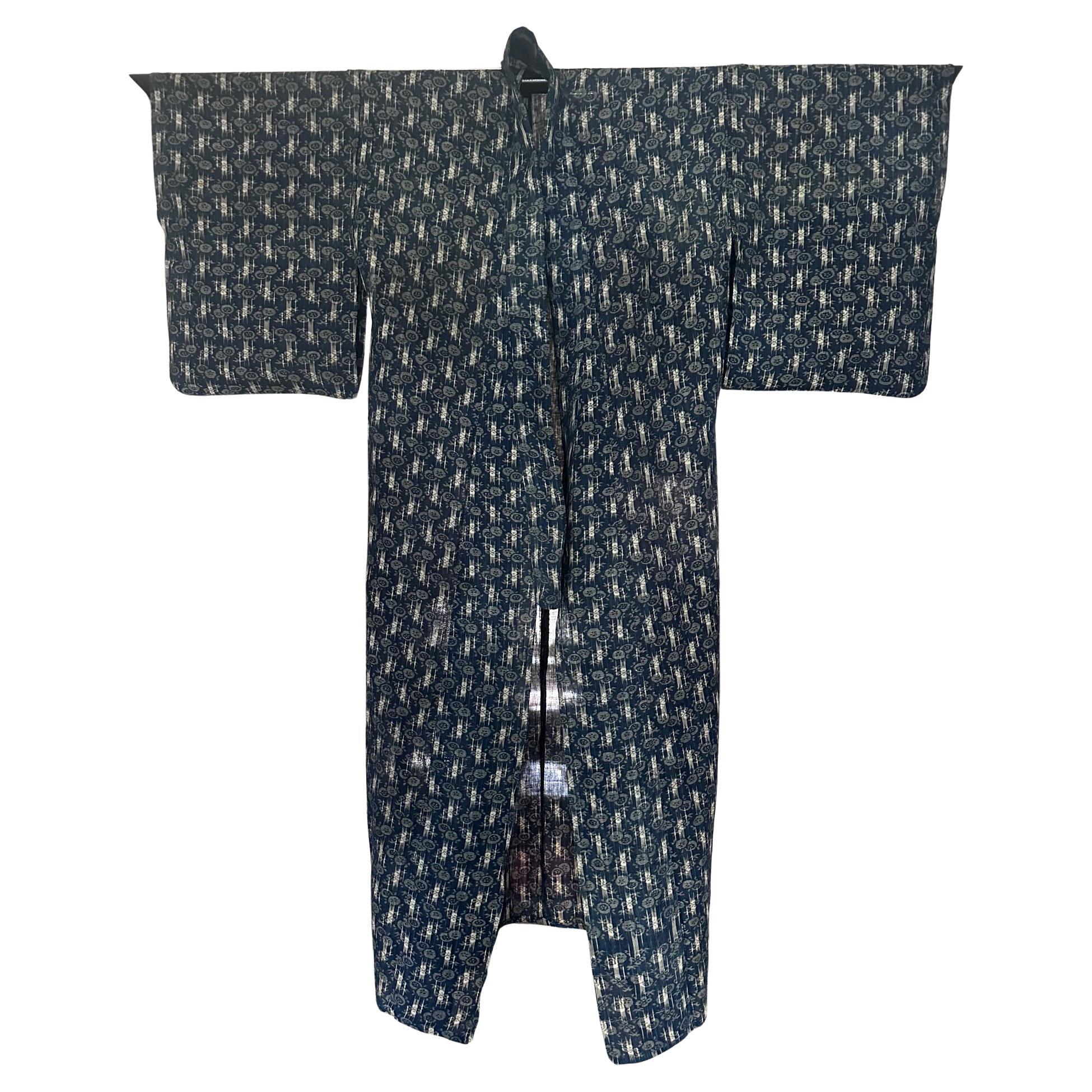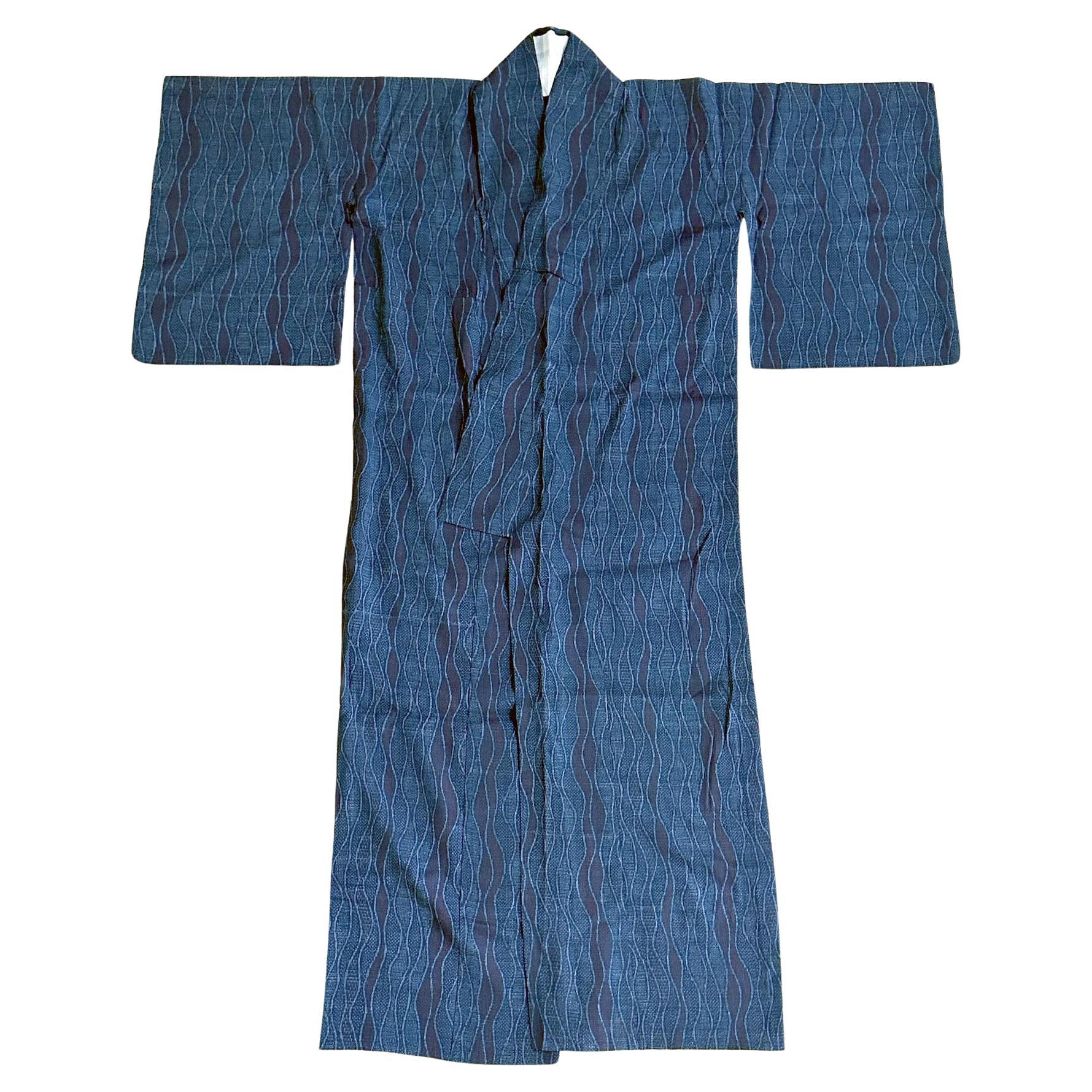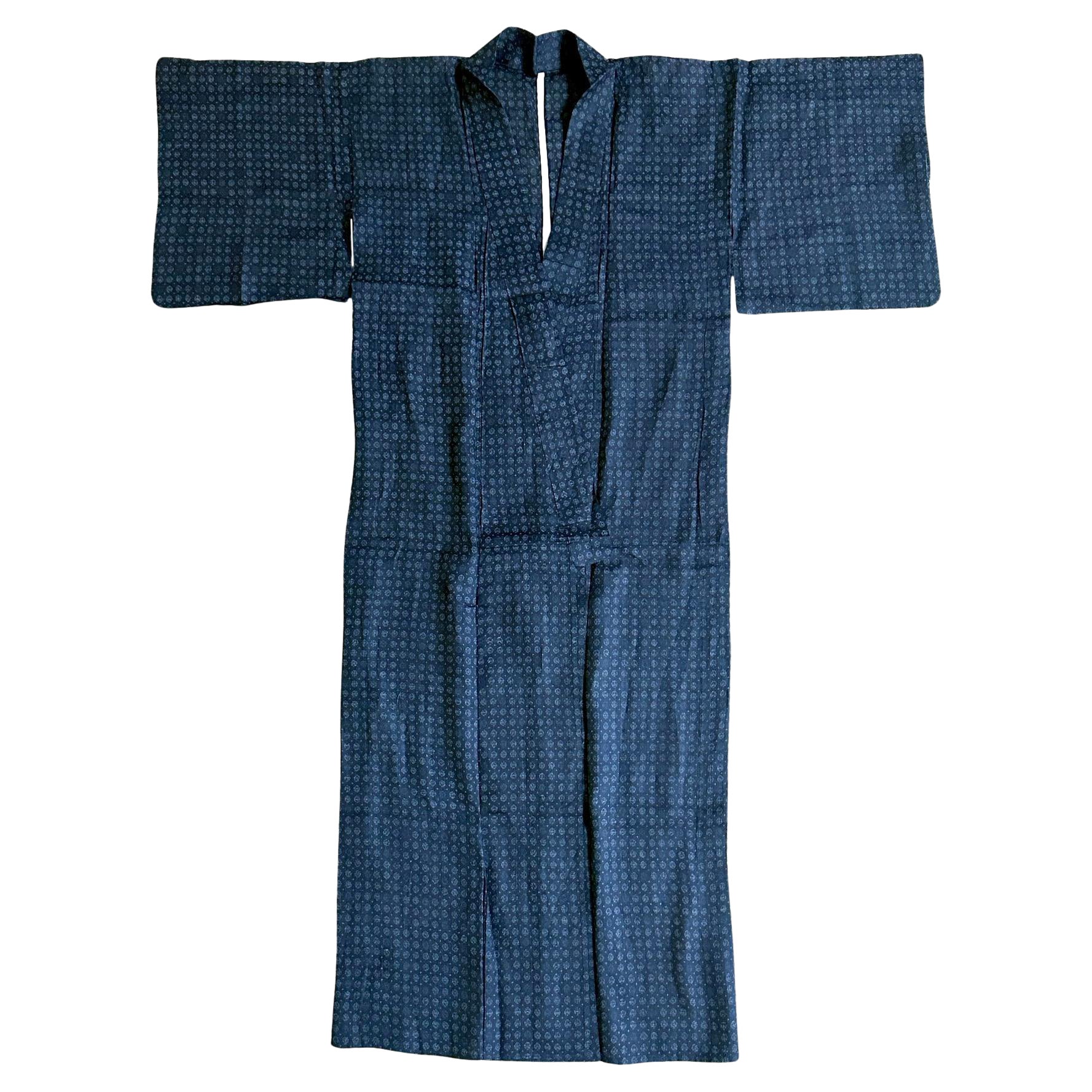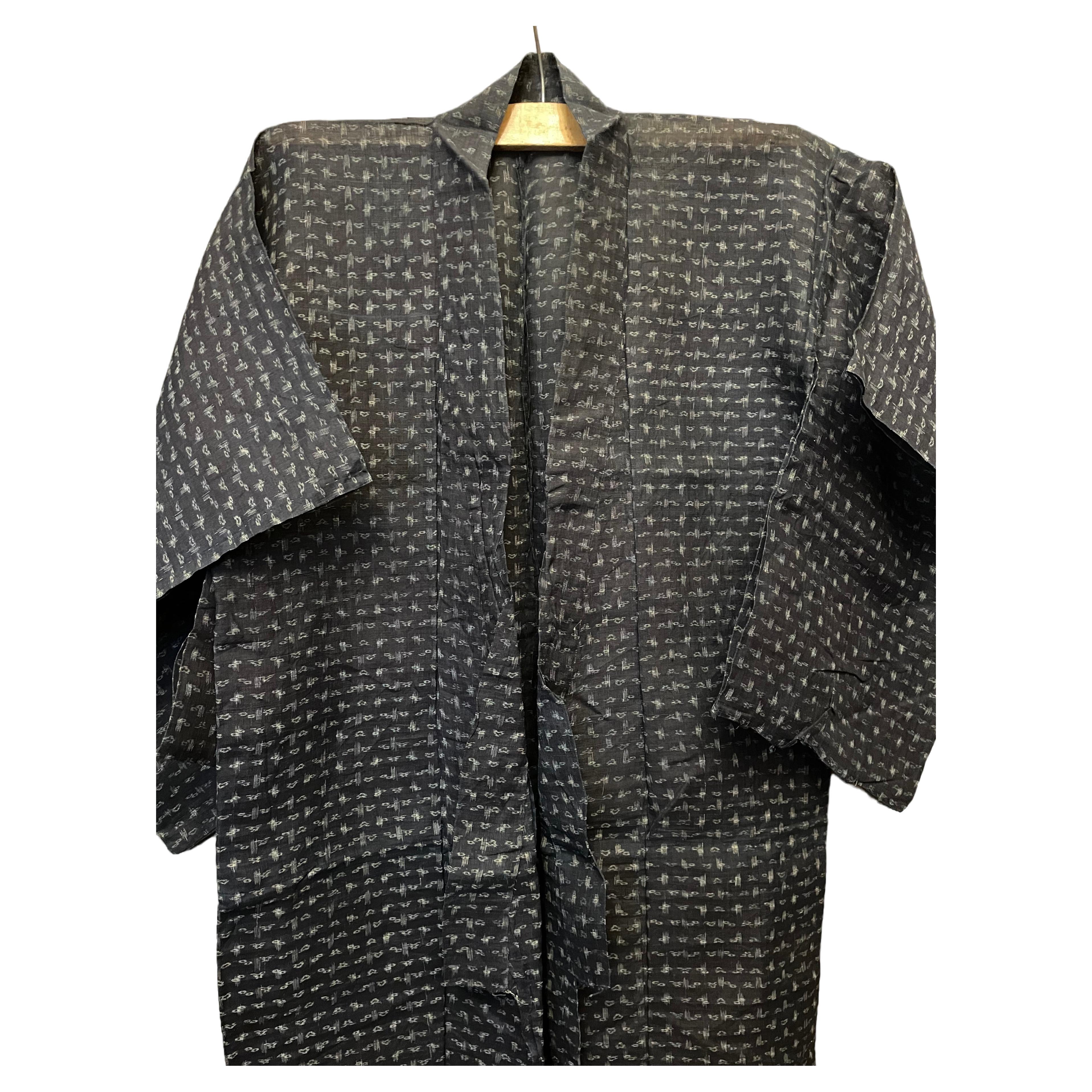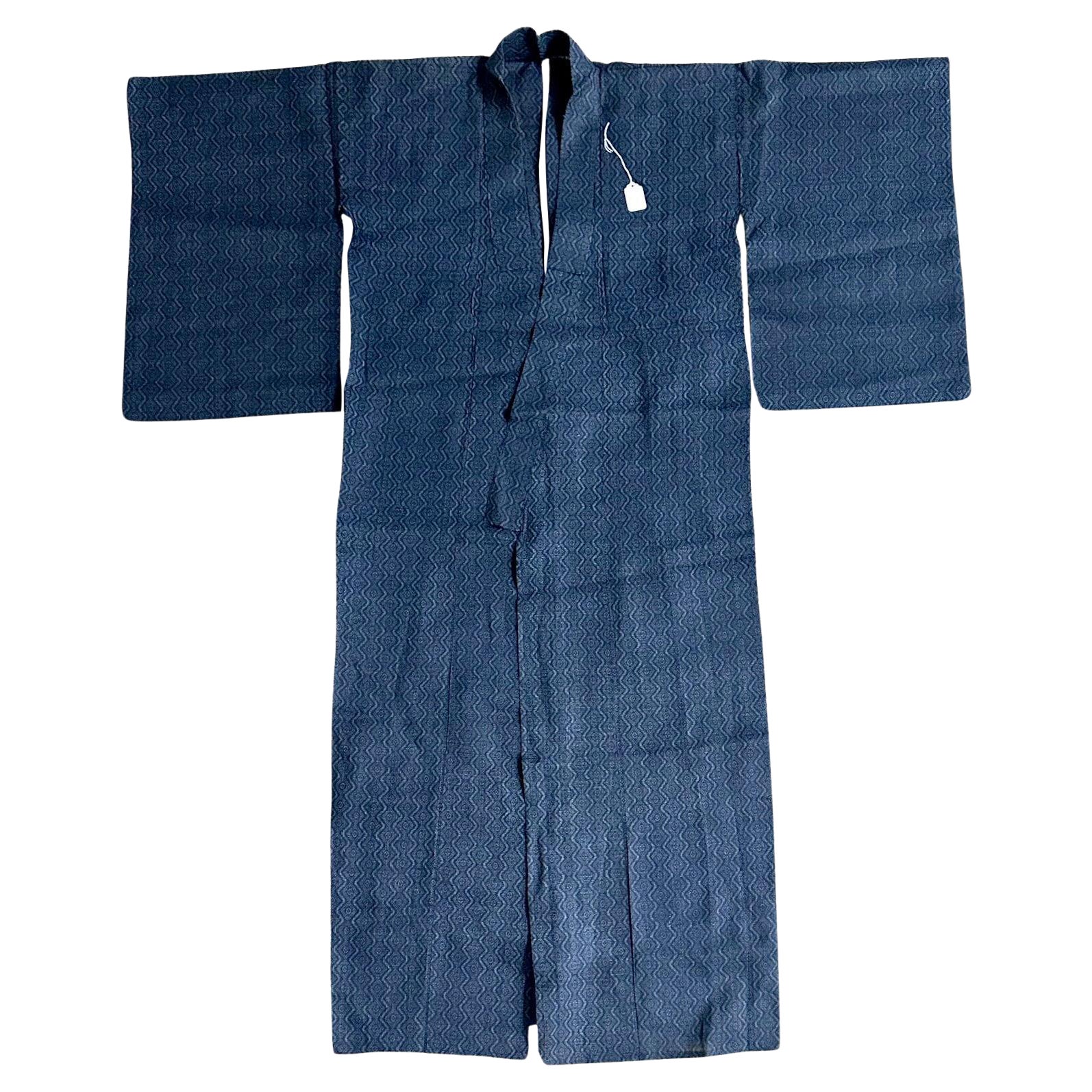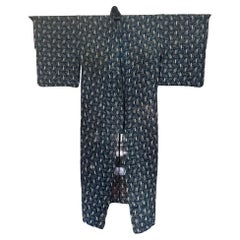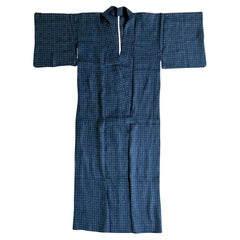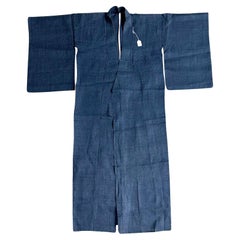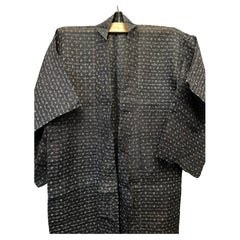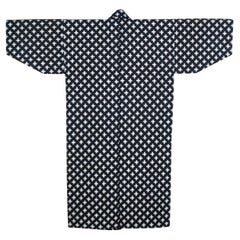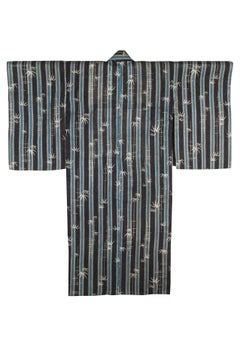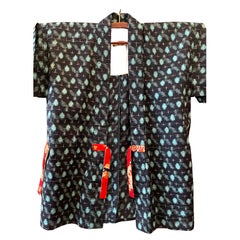Items Similar to Rare Japanese Woven Ikat Child Kimono Nemaki
Want more images or videos?
Request additional images or videos from the seller
1 of 17
Rare Japanese Woven Ikat Child Kimono Nemaki
$3,200
£2,446.57
€2,817.95
CA$4,484.18
A$5,006.17
CHF 2,623.16
MX$61,280.39
NOK 33,314.11
SEK 31,410.97
DKK 21,030.69
Shipping
Retrieving quote...The 1stDibs Promise:
Authenticity Guarantee,
Money-Back Guarantee,
24-Hour Cancellation
About the Item
A rare and well preserved Japanese woven child's kimono circa early 20th century (end of Meiji period). The small kimono was a great example of Nemaki (sleepwear) for a young boy, identified by its size and distinct attached and tapered sleeves with opening under the armpits. The distinguished weaving is double-ikat (called Tate-Yoko Kasuri in Japanese), in which both wefts and warps were pre-dyed with resistant paste to create a slightly blurry edges on the squared design, both vertically and horizontally. The white square pattern covers the entire surface. The repetition, the subtle variations and the blurred images make the piece visually arresting. One of the most difficult techniques to master, the demanded precision of the pre-dye is the key to the creation. Closer inspection of the garment further reveals that it was lovely made with great details and care. Subtle plaiting was placed on the front lapel as well as the back shoulder areas. Small loops were sewn onto the chest area (for tie closure). The back of the kimono was lined with a brown fabric with ikat pattern for durability. The end of the inner sleeves was lined with dark blue silk stripes for the same purpose. The Nemaki garment was likely made for a boy of a wealthy family and wasn't used extensively based on the well-preserved condition.
For a similar boy's Nemaki kimono, see "Textile of Japan" Prestel, page 282, illustration 96.
IIkat weaving was originated in Southeast Asia and spread to Japan Mainland in the 17th century via Okinawa (14th century). The cotton production accelerated the development of the textile industry on a much larger scale by then in the Edo period when Kasuri became very popular among the general population.
- Dimensions:Height: 30 in (76.2 cm)Width: 37.5 in (95.25 cm)Depth: 1 in (2.54 cm)
- Style:Meiji (Of the Period)
- Materials and Techniques:Cotton,Ikat
- Place of Origin:
- Period:
- Date of Manufacture:Early 20th Century
- Condition:Wear consistent with age and use. Overall good condition as a well-preserved example. Little wear with minor scattered spots of stains.
- Seller Location:Atlanta, GA
- Reference Number:1stDibs: LU945034556612
About the Seller
4.9
Platinum Seller
Premium sellers with a 4.7+ rating and 24-hour response times
Established in 2006
1stDibs seller since 2010
564 sales on 1stDibs
Typical response time: <1 hour
- ShippingRetrieving quote...Shipping from: Atlanta, GA
- Return Policy
Authenticity Guarantee
In the unlikely event there’s an issue with an item’s authenticity, contact us within 1 year for a full refund. DetailsMoney-Back Guarantee
If your item is not as described, is damaged in transit, or does not arrive, contact us within 7 days for a full refund. Details24-Hour Cancellation
You have a 24-hour grace period in which to reconsider your purchase, with no questions asked.Vetted Professional Sellers
Our world-class sellers must adhere to strict standards for service and quality, maintaining the integrity of our listings.Price-Match Guarantee
If you find that a seller listed the same item for a lower price elsewhere, we’ll match it.Trusted Global Delivery
Our best-in-class carrier network provides specialized shipping options worldwide, including custom delivery.More From This Seller
View AllJapanese Woven Ikat and Stenciled Summer Usumono Kimono Meiji Period
Located in Atlanta, GA
On offer is a “Natsu No Kimono” (summer kimono) also called “Usumono" (thin clothes) dated from late Meiji Period circa late 19th to early 20th century. This well-preserved garment w...
Category
Early 20th Century Japanese Meiji Textiles
Materials
Linen
Japanese Woven Asa Double Ikat Summer Usumono Kimono Provenance
Located in Atlanta, GA
A “Natsu No Kimono” (summer kimono) also called “Usumono" (thin clothes) dated from early 20th century Taisho Period. This well-preserved garment was tailored from a woven indigo blu...
Category
Early 20th Century Japanese Taisho Textiles
Materials
Linen
Japanese Woven Asa Double Ikat Summer Usumono Kimono Provenance
Located in Atlanta, GA
On offer is a “Natsu No Kimono” (summer kimono) also called “Usumono" (thin clothes) dated from early 20th century Taisho Period. This well-preserved garment was tailored from a wove...
Category
Early 20th Century Japanese Taisho Textiles
Materials
Hemp
Japanese Woven Asa Double Ikat Summer Usumono Kimono Provenance
Located in Atlanta, GA
A “Natsu No Kimono” (summer kimono) also called “Usumono" (thin clothes) dated from early 20th century Taisho Period. This well-preserved garment was tailored from a woven indigo blu...
Category
Early 20th Century Japanese Taisho Textiles
Materials
Hemp
Japanese Art Deco Ikat Silk Meisen Kimono
Located in Atlanta, GA
A well preserved Japanese Meisen kimono hand-sewn from woven Ikat Silk circa 1920-30s (Taisho to early Showa period). The kosode style kimono (small slee...
Category
Early 20th Century Japanese Showa Textiles
Materials
Silk
Japanese Art Deco Ikat Silk Meisen Kimono
Located in Atlanta, GA
A striking and well preserved Japanese Meisen kimono hand-sewn from woven Ikat Silk circa 1920-40s (Taisho to Showa period). The kosode style kimono (sma...
Category
Early 20th Century Japanese Showa Textiles
Materials
Silk
You May Also Like
Japanese Cotton Kimono IKAT Kasuri 1970s Showa
Located in Paris, FR
This is a kimono made in Japan called kasuri. This kasuri kimono was made around 1970s.
It was used to wear by some peasants to work. This is made with cotton Ikat.
Dimensions:
Heig...
Category
Vintage 1970s Japanese Showa Antiquities
Materials
Cotton
Antique Japanese Indigo-Dyed Double Ikat Kimono
Located in Point Richmond, CA
Antique Japanese Indigo-Dyed Double Ikat Kimono
This deeply saturated indigo-dyed kimono is made of heavy-weight hand-spun cotton and precisely patter...
Category
Early 20th Century Japanese Taisho Tribal Art
Materials
Cotton
Taisho-Early Showa Period Japanese Stencil-Dyed Summer Kimono with Bamboo Motif
Located in Point Richmond, CA
Taisho-Early Showa period Japanese Stencil-Dyed Summer Kimono with bamboo Motif
A light-weight summer kimono woven of both cotton and silk, and patter...
Category
Mid-20th Century Japanese Taisho Textiles
Materials
Cotton, Silk
Japanese Ikat Peasant Cotton Kasuri Jacket with Belts 1970s
Located in Paris, FR
This is a jacket made in Japan called kasuri. This kasuri jacket was made around 1970s.
It was used to wear by some peasants to work. This is made with cotton Ikat.
Dimensions:
Heig...
Category
Late 20th Century Japanese Showa Antiquities
Materials
Cotton
Japanese Ikat Peasant Kasuri (Haori style) Jacket with Cotton 1970s
Located in Paris, FR
This is a jacket made in Japan called kasuri. This kasuri jacket was made around 1970s.
It was used to wear by some peasants to work. This is made with cotton Ikat.
Dimensions:
Heig...
Category
Late 20th Century Japanese Showa Antiquities
Materials
Cotton
Late Meiji Period Sleeping Kimono / Yogi, Japan
Located in Point Richmond, CA
Late Meiji Period sleeping Kimono / Yogi, Japan
Yogi are a type of oversized sleeping kimono traditionally used in Japan. This kimono would have b...
Category
Early 20th Century Japanese Tribal Textiles
Materials
Cotton
